Our first view (and first impression) of a book can be it's spine. Sitting on a bookshelf with much competition and little real estate, first impressions need to be good, especially if you're a newcomer. These books fill all those requirements, beautifully.
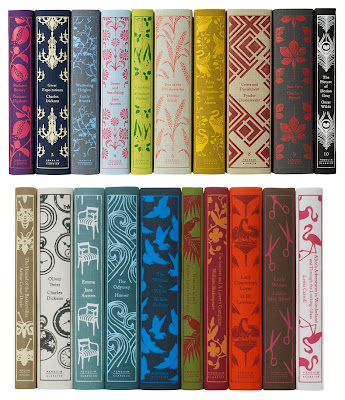 |
| Penguin Classics |
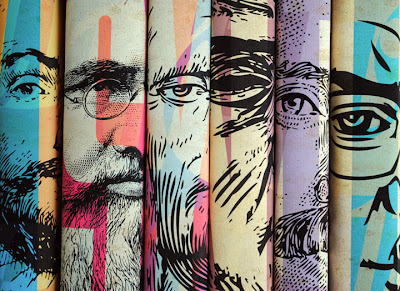 |
| Jonathan Boarini If you can make economic books look like these, then I think you have a pretty creative mind and bright future. |
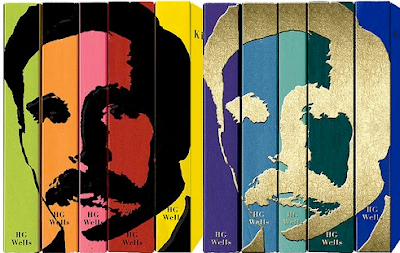 |
| Letterology |
 |
| Letterology
0 Comments on Book Spine Design - You're So Fine as of 11/29/2011 10:22:00 PM
Add a Comment
By: L.,
on 11/11/2009
Blog: Jacket Whys (Login to Add to MyJacketFlap) JacketFlap tags: color, book covers, book spines, paperback changes, Add a tag
I remember thinking “yuck, chicklit” when I first saw the cover of Suite Scarlett by Maureen Johnson (Point 2008). Nothing against people who like it, but it doesn’t draw me in unless there’s so much buzz about the book that I need to be in the know.
I love background stories for book covers, and on her blog, Maureen Johnson gives some backstory in response to someone who expressed dislike of the hardcover cover:
Johnson responds:
She adds cover commentary:
I agree with her – many covers have absolutely nothing to do with what’s inside. STILL t
0 Comments on Scarlett and the Velour Wallpaper as of 1/1/1900
Add a Comment
By: L.,
on 9/21/2009
Blog: Jacket Whys (Login to Add to MyJacketFlap) JacketFlap tags: fonts, color, book spines, Add a tag
I find book spines to be much more difficult to critique than the book faceout. It’s harder to define elements that attract, when space is so limited and so much has to fit.
With these defined elements in mind, I snapped a few pictures of spines that I thought succeeded in jumping out and saying “look at me!”
The Septimus Heap series by Angie Sage has a lot to work with because the books are so fat! But the designer did a lot with the faux old book look, foiled fonts, graphic elements and standout background colors. Love these!

4 Comments on Spinal Talk, last added: 9/24/2009
Display Comments
Add a Comment
By: L.,
on 9/17/2009
Blog: Jacket Whys (Login to Add to MyJacketFlap) JacketFlap tags: book spines, Add a tag
Whoa, life intervenes and sometimes it’s hard to get a post together. In the meantime, check out this interview with Coralie Bickford-Smith, book designer for Penguin books (not YA, but still…). A challenge for you! Look at your shelves with a critical eye toward spines. Send me a photo of a particularly pleasing serendipitous collection of spines. I’ll display them here with your commentary and/or mine. 
0 Comments on Spine Challenge! as of 1/1/1900
Add a Comment
By: L.,
on 7/13/2009
Blog: Jacket Whys (Login to Add to MyJacketFlap) JacketFlap tags: color, book covers, symbols, book spines, Add a tag
Crime tape seems to me like a perfect graphic image, and it’s surprising that it’s not used more often. The book covers below are the only ones I could track down, and three of the first four are from Simon & Schuster. Usually when I’ve put together a group like this, I find that all are from different publishers. So this is an unsual grouping on that count.
The Year of the Bomb by Ronald Kidd and Just Another Hero by Sharon M. Draper are both new this year and both from Simon & Schuster. These differ from the above two in that the title text is what appears on the tape.
Three of the above are about guns brought to school. The image makes sense for the subject.
Give a Boy a Gun: Events leading up to a night of terror at a high school dance are told from the point of view of various people involved. Ages . Reviews 1, 2, 3, 4. 
1 Comments on Crime Tape, last added: 7/16/2009
Display Comments
Add a Comment
By: L.,
on 1/12/2009
Blog: Jacket Whys (Login to Add to MyJacketFlap) JacketFlap tags: book covers, book spines, best book jackets, Add a tag
After looking at hundreds of 2008 children’s and YA fiction book covers, I’ve narrowed it down to my ten favorites. Here are the first three, in no particular order. Each time I saw the cover of Triskellion by Will Peterson [Mark Billingham & Peter Cocks] (Candlewick) this year, it caught my attention and intrigued me. 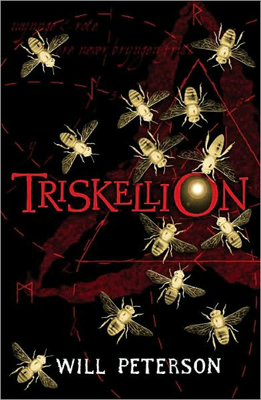 The white-gold bee silhouettes are beautiful by themselves (I’m a sucker for insect shapes). They stand out against the black and red background, circling and drawn to a light focused nicely in the “O” of the title. The off-center triangle and surrounding red dashed lines, the trillium shape, and the perfectly selected font… Each adds to the whole. Candlewick doesn’t credit the designer, on the flap, but they should! The white-gold bee silhouettes are beautiful by themselves (I’m a sucker for insect shapes). They stand out against the black and red background, circling and drawn to a light focused nicely in the “O” of the title. The off-center triangle and surrounding red dashed lines, the trillium shape, and the perfectly selected font… Each adds to the whole. Candlewick doesn’t credit the designer, on the flap, but they should!
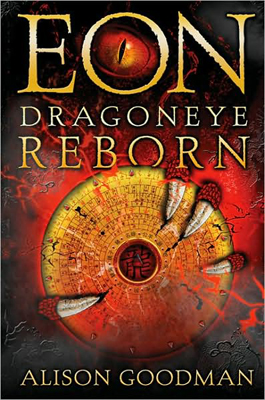 Eon: Dragoneye Reborn by Alison Goodman (Viking) made my top ten first time I saw it. The exciting, mysterious art is just what a book needs to grab hold of potential readers. And I’m not the only one who loved this cover. Many of the reviews linked below mentioned the cover draw. Eon: Dragoneye Reborn by Alison Goodman (Viking) made my top ten first time I saw it. The exciting, mysterious art is just what a book needs to grab hold of potential readers. And I’m not the only one who loved this cover. Many of the reviews linked below mentioned the cover draw.
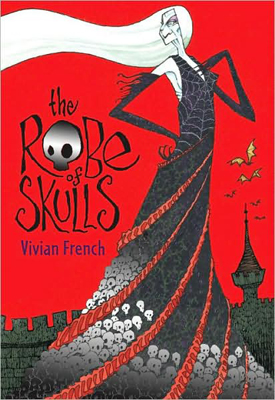 Silver foil can be overused, but it’s perfect on The Robe of Skulls by Vivian French (Candlewick). Only the skulls are silver. The skull in place of the “O” in Robe is a nice touch. Silver foil can be overused, but it’s perfect on The Robe of Skulls by Vivian French (Candlewick). Only the skulls are silver. The skull in place of the “O” in Robe is a nice touch.
All of these titles have meshed the art beautifully with the title and author fonts and placement. Triskellion and Robe of Skulls both have great spines as well. I haven’t had a copy of Eon in my hands yet. Don’t know the designer and haven’t seen the spine. Triskellion: When fourteen-year-old twins Adam and Rachel go to visit their grandmother in an unwelcoming and ancient English village, they realize that there is something unnatural about it and are swept up in an archaeological mystery. Age 13+. Reviews, 1, 2, 3. 
7 Comments on Best Covers of 2008 - Part 1, last added: 2/2/2009
Display Comments
Add a Comment
|



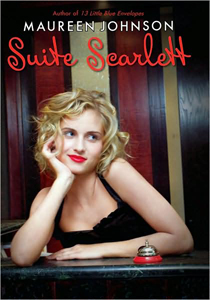
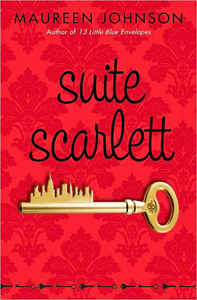
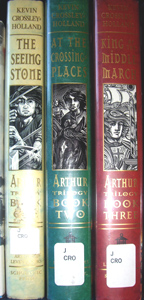
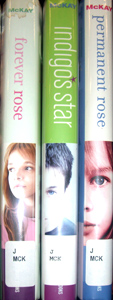
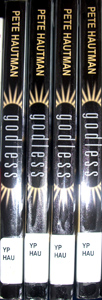
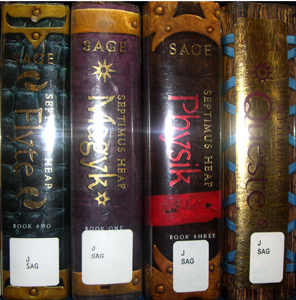
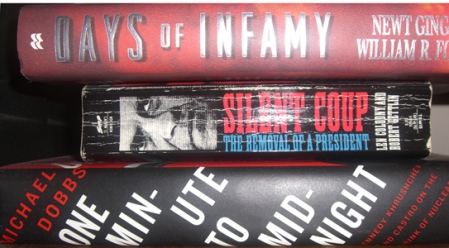

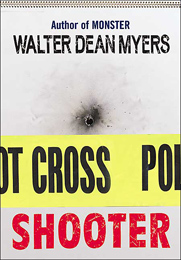

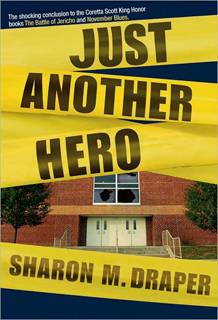
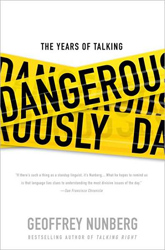
My suggestion for the post you’re working on is Kimchi and Calamari by Rose Kent.